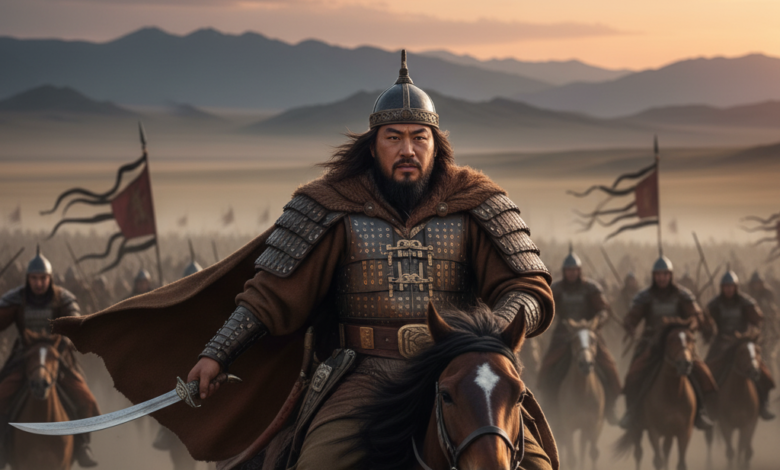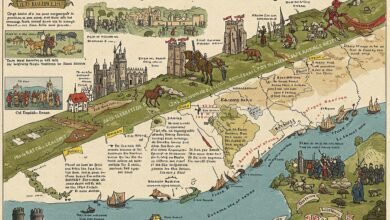The Rise of the Mongol Empire: From Nomadic Tribes to Global Power

Introduction to the Mongol Empire
The Mongol Empire, which emerged in the 13th century, stands as one of the largest contiguous empires in history. Originating from the nomadic tribes of the Central Asian steppes, the empire’s formation was significantly influenced by its unique cultural, military, and political aspects. The Mongols, who were traditionally pastoralists, utilized their skills in horseback riding and archery to forge a formidable cavalry, setting the stage for their remarkable conquests across vast territories.
Under the leadership of Genghis Khan, the Mongol tribes unified, marking a transformative period in their history. His military strategies were both innovative and effective, emphasizing speed, intelligence, and psychological warfare. This approach allowed the Mongols to outmaneuver and outsmart their adversaries, leading to a series of swift incursions into territories spanning Asia and Europe, significantly impacting the socio-political landscape of the regions concerned.
The rise of the Mongol Empire not only redefined traditional power dynamics but also facilitated cultural exchanges across continents. The empire acted as a conduit for trade and interaction between diverse civilizations, contributing to a degree of globalization unprecedented at the time. The Silk Road, which traversed the Mongol realm, served as a vital link for the flow of goods, ideas, and technologies, enhancing its influence far beyond its borders.
As the Mongol Empire expanded, it incorporated various cultures, allowing for a unique fusion that would characterize its governance and societal structures. This blend of nomadic traditions with settled civilizations created a dynamic environment that propelled the empire’s evolution into a significant global power. Understanding the Mongol Empire’s rise is essential to grasping its historical importance and the lasting impacts it has had on the world.
The Origins of the Mongol Tribes
The early history of the Mongol tribes is characterized by a nomadic lifestyle that defined their social structure and cultural practices. The Mongols primarily inhabited the vast steppes of Central Asia, a region that necessitated a mobile way of life due to its harsh climate and fluctuating resources. This nomadic existence revolved around herding animals, particularly horses, sheep, and goats, which served as vital sources of sustenance and transportation. The Mongol people developed intricate knowledge of their environment, enabling them to adapt to the challenges posed by the natural landscape.
Tribal organization played a crucial role in the social framework of the Mongols. Society was typically divided into clans, which were further grouped into larger tribal confederations. These clans provided not only a sense of identity but also facilitated cooperation in various aspects of life, including hunting, warfare, and resource management. Leadership within these tribes was often based on merit and demonstrated capabilities rather than hereditary status, allowing for agile responses to shifting circumstances. This flexibility was particularly evident during periods of conflict with neighboring peoples, such as the Khitan and the Jin Dynasty.
Cultural practices among the Mongol tribes were deeply intertwined with their nomadic lifestyle. Oral traditions, storytelling, and music played a vital role in preserving their history and reinforcing social bonds. Furthermore, the Mongols were known for their skills in horseback riding and archery, which enhanced their reputation as formidable warriors. Interactions with neighboring cultures, including trade and warfare, influenced their practices and contributed to their identity. Key figures such as Genghis Khan would later emerge from this historical backdrop, uniting the tribes and laying the foundation for what would become the vast Mongol Empire. Thus, understanding the origins of the Mongol tribes provides crucial context for their eventual rise to power on the global stage.
Genghis Khan: The Unifier of the Mongols
Genghis Khan, born as Temüjin around 1162, was a figure who would redefine the course of history for not only the Mongol tribes but for the entire world. His early life was marked by hardship; the assassination of his father led to a tumultuous childhood characterized by strife and struggles for survival. Growing up amid the fractious landscape of Mongolian tribal politics, Temüjin developed a keen understanding of the volatile dynamics that governed tribal relations.
Faced with the challenge of uniting disparate tribes, Temüjin began to forge alliances through marriage and diplomacy. His union with Börte, who came from a prominent family, enabled him to gain initial support and legitimacy. Furthermore, he was able to attract followers by demonstrating exceptional leadership qualities that emphasized loyalty, meritocracy, and shared purpose. These strategies were pivotal in overcoming the deeply entrenched animosities among the tribes. Rather than relying solely on traditional aristocratic power structures, Genghis Khan promoted individuals based on skill and loyalty, ensuring a more unified command.
His leadership style transformed the Mongol identity from fragmented tribal units into a cohesive entity. Genghis Khan’s vision extended beyond mere conquest; he aimed to create a vast empire that facilitated trade and cultural exchanges. By establishing the Yassa, a code of laws, he encouraged order and discipline within his ranks, further solidifying his control. This innovative approach not only unified the Mongol tribes but also instilled a sense of shared destiny among them. Genghis Khan’s ability to weave together various factions under a common banner laid the groundwork for the emergence of the Mongol Empire, which would later stretch across vast territories, connecting East and West in remarkable ways.
Military Innovations and Strategies
The rise of the Mongol Empire can be significantly attributed to its groundbreaking military innovations and strategies, which allowed the nomadic tribes to evolve into a formidable global power. Central to their success was an unparalleled reliance on cavalry tactics. Mongol warriors were skilled horsemen, capable of executing complex maneuvers and maintaining high speeds over treacherous terrains. The effectiveness of their mobile cavalry units, which could shoot arrows accurately while riding at full gallop, provided them with a distinct advantage in battles against larger, less mobile armies.
In addition to superior cavalry tactics, the Mongol Empire excelled in psychological warfare, leveraging fear as a weapon. The Mongols cultivated an image of brutality and ruthlessness; they often resorted to terror tactics to demoralize their opponents before engaging in battle. This approach not only weakened enemy resolve but allowed the Mongols to conquer cities with minimal loss of life, as some adversaries surrendered without a fight, fearing the dire consequences of resistance. Such methods ensured the rapid spread of Mongol influence across vast territories.
Moreover, the Mongols employed sophisticated intelligence networks, utilizing scouts and spies to gather information on enemy positions and tactics. This capability to obtain actionable intelligence allowed them to adapt swiftly to changing circumstances on the battlefield, as well as anticipate enemy movements. The integration of conquered peoples into their military structure also proved advantageous, as it enabled the Mongols to enhance their numerical strength and incorporate diverse combat techniques, thereby enriching their strategic repertoire.
These military innovations and strategies set the Mongols apart from their contemporaries, ultimately facilitating their rise as one of history’s most expansive empires. The combination of skilled cavalry, psychological manipulation, intelligence gathering, and inclusive military practices contributed significantly to the Mongol Empire’s impressive conquests.
The Expansion of the Mongol Empire
The expansion of the Mongol Empire during the 13th century marked one of the most significant transformations in history, driven by the military prowess and strategic vision of Genghis Khan and his successors. Following the unification of the Mongol tribes in 1206, Genghis Khan launched a series of campaigns that would result in the empire expanding at an unprecedented pace. The initial focus was on the neighboring territories of the Tangut and Jin dynasties. These early campaigns set the tone for more extensive conquests as the Mongols demonstrated their formidable tactics, including rapid cavalry maneuvers and psychological warfare.
One of the most notable conquests was that of the Khwarezmian Empire in 1219. Following a diplomatic failure, Genghis Khan retaliated by orchestrating a decisive military campaign. The Mongol forces, employing sophisticated siege techniques and utilizing superior horse-riding skills, swiftly dismantled the Khwarezmian cities, conquering Samarkand and Bukhara. This campaign not only highlighted the Mongols’ strategic acumen but also initiated a wave of terror that accompanied their invasions, prompting many other regions to submit preemptively.
As the Mongol Empire expanded, it incorporated diverse cultures, from Chinese cities to Persian principalities. The Mongols adopted various administrative practices, allowing local rulers to maintain some degree of autonomy while paying tribute. This approach fostered cooperation among conquered peoples, which was critical in managing a vast and culturally mixed empire. Moreover, the Mongol postal system, known as the Yam, facilitated communication across their expansive territories, enhancing governance and control.
In essence, the expansion of the Mongol Empire was characterized by a combination of military innovation and administrative flexibility, enabling it to subjugate numerous cultures and lay the groundwork for a global power that would influence the course of history for centuries to come.
The Cultural and Economic Exchange
The Mongol Empire, at its height, became a vital hub for cultural and economic exchanges between the East and West. One of the most significant contributions of the Mongol Empire was its role in revitalizing and securing trade routes such as the famous Silk Road. This network not only facilitated the movement of goods but also promoted the interaction of diverse cultures. Merchants, travelers, and explorers traversed these paths, resulting in an enriching exchange of ideas, technologies, and philosophies that transformed various societies.
The Mongols were instrumental in promoting trade by offering protection to traders journeying across vast territories. This assurance led to increased economic activity and collaboration across regions, allowing luxury goods, including silk, spices, and precious stones, to flow freely between Europe and Asia. Furthermore, the integration of diverse cultures led to innovative advancements in various fields, including agriculture and metallurgy. For instance, papermaking, which originated in China, spread westward along the Silk Road, revolutionizing communication and record-keeping in multiple cultures.
In addition to economic trade, the Mongol Empire’s policies fostered an environment where religious tolerance flourished. Various belief systems, including Buddhism, Islam, and Christianity, coexisted and influenced one another as the nomadic tribes transitioned into rulers of a vast empire. This coexistence led to the sharing of knowledge and practices, enriching cultural traditions. The Mongolian leadership actively encouraged diplomacy and learning, which in turn allowed for the exchange of literature, arts, and even scientific discoveries. As scholars and artists mingled across borders, the world witnessed remarkable cultural advancements that would leave a lasting legacy.
Through these mechanisms, the Mongol Empire significantly influenced cultural and economic dynamics between the East and West, thus playing a transformative role in shaping the course of history during its reign.
Administration and Governance
The administration of the Mongol Empire marked a significant evolution from their nomadic origins to an expansive global power. To effectively govern the vast territories they conquered, the Mongols established a comprehensive administrative system that was adaptable and efficient. This system was primarily structured around the needs of governance rather than a rigid bureaucratic hierarchy, which allowed the Mongol rulers to maintain control over diverse populations while promoting regional autonomy.
A notable aspect of Mongol governance was the creation of a meritocratic system. The Mongols recognized the value of skilled administrators and local leaders regardless of their ethnicity. As a result, they often appointed skilled individuals based on merit, allowing local customs and governance practices to flourish under a broader Mongol framework. This approach not only facilitated effective administration but also fostered loyalty among the local populations, who felt their needs and traditions were respected within the Mongol rule.
The integration of local customs was another critical element in the Mongols’ administration. As they expanded into various territories, the Mongols encountered distinct cultural practices and legal systems. Instead of enforcing a singular approach, they opted for a more inclusive model, which allowed different regions to uphold their indigenous laws and traditions, provided they remained loyal to the empire and paid taxes. This flexibility helped to ease the transition for conquered peoples and facilitated smoother governance across the empire’s extensive borders.
Ultimately, the Mongol Empire’s deft balance between control and autonomy serves as a compelling example of governance in a multicultural context. By combining effective administration, a merit-driven leadership model, and respect for local customs, the Mongols not only unified a diverse collection of tribes and peoples but also laid the groundwork for lasting stability within their expansive realm.
The Decline of the Mongol Empire
The decline of the Mongol Empire, which once stood as a formidable global power, can be attributed to a myriad of interconnected factors. One of the most significant reasons for its fragmentation was the vastness of its territory, which became increasingly difficult to manage. As the empire expanded, it was divided into various khanates, each governed by different leaders. This decentralization weakened the central authority, resulting in a lack of cohesive governance and a sense of disunity among the various regions. The inability to maintain firm control across such a large area facilitated the rise of local powers and discontent among conquered populations.
Internal strife played a critical role in the empire’s decline. Following the death of Genghis Khan, succession crises emerged, leading to power struggles among his descendants. These conflicts not only diverted resources and attention from external threats but also weakened the empire’s military prowess. The infighting resulted in rival factions that vied for power, which further exacerbated the sense of instability within the empire. As a consequence, the once-cohesive Mongol identity began to fragment into distinct regional identities.
Moreover, the emergence of new powers posed significant challenges to the Mongol Empire. The rise of states such as the Ming Dynasty in China and the emergence of Persian and Russian principalities highlighted the shifting balance of power in the region. These powers took advantage of the Mongols’ internal weaknesses, reclaiming territories and establishing their dominance. The Mongol forces found themselves outmaneuvered by these rising states, which utilized innovative military strategies that the Mongols had not adapted to. Ultimately, the cumulative effects of fragmentation, internal strife, and external challenges contributed to the decline of the Mongol Empire, leaving a profound impact on global history.
Legacy of the Mongol Empire
The Mongol Empire, at its peak, was the largest contiguous empire in history, stretching across vast regions of Asia and into Europe. This immense territorial expanse played a significant role in shaping trade routes, most notably the Silk Road, which was fundamental for the exchange of goods, culture, and ideas between East and West. The Mongols facilitated the expansion of trade networks that connected diverse civilizations, enabling not only the flow of commodities but also the transmission of technological innovations and cultural practices. This thriving exchange under Mongol rule laid the groundwork for economic interdependence that continued long after the empire’s decline.
Furthermore, the Mongol Empire’s impact on cultural exchange cannot be overstated. The empire acted as a conduit for the dissemination of knowledge, leading to a rich blend of cultures and traditions. Institutions like the Pax Mongolica promoted stability, allowing scholars, artisans, and explorers from various backgrounds to collaborate and share ideas. This cultural syncretism contributed to advancements in various fields, including mathematics, astronomy, and medicine. The legacy of these scholarly exchanges can be seen in the ways contemporary societies continue to benefit from cross-cultural dialogue.
Moreover, the geopolitical landscape of Eurasia was indelibly marked by the Mongol conquests. The strategies employed by the Mongols in warfare and governance influenced subsequent empires and nations, shaping military tactics and administrative practices for generations. Historical representations of the Mongols often depict them as fierce warriors, but this oversimplification neglects their role as state builders and patrons of trade and culture. In modern popular culture, the Mongols are frequently romanticized or demonized; however, their historical significance remains complex and multifaceted, presenting an enduring legacy that continues to inspire interest and debate among historians and scholars today.






















